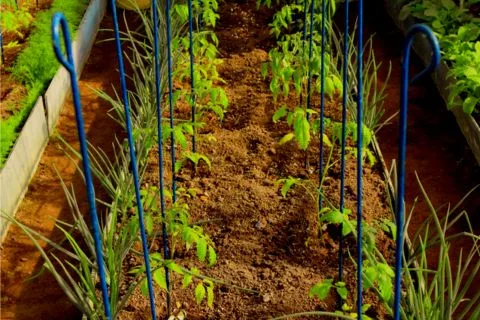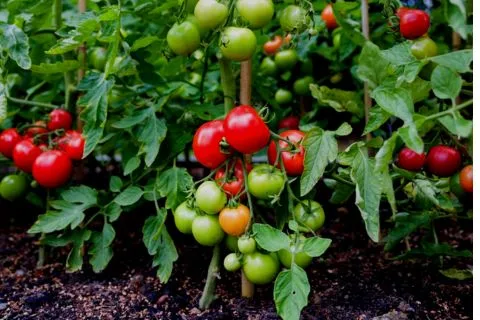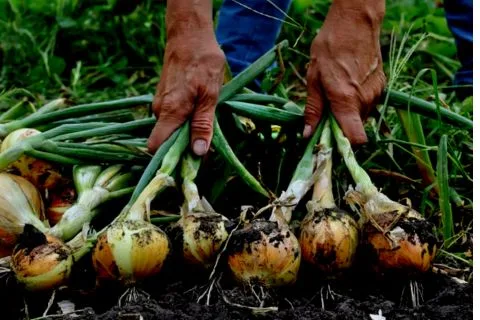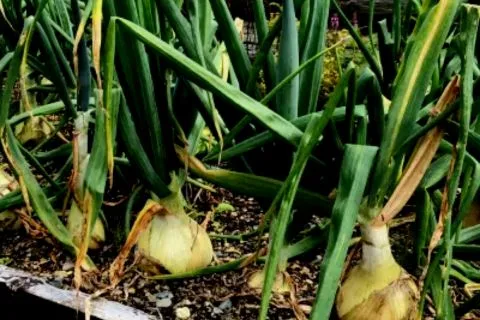Everybody, including the plants in your garden, needs a friend who will remain alongside them. Planting onions next to and around tomatoes acts as a natural bug deterrent, protecting the valuable tomatoes from damaging insects. Like gardening buddies, companion planting is a technique. This is the concept that specific plants can cooperate to promote mutual growth, fight against pests, enhance soil quality, and boost overall production.

When it comes to planting friends, onions are not something to be discouraged about. Because they are so effective at fighting against pests of all kinds, they are sort of the MVPs of companion planting. Bugs like aphids, thrips, and gnats will flee from these odoriferous, spherical vegetables because of their potent smell. Not only do onions themselves receive protection from this superpower, but the force field they produce also protects adjacent plants. Furthermore, tomatoes and onions make a delicious combination in food, so why wouldn’t they work well together in your garden?
Concept behind the Strategy of Companion Planting
The science underlying this buddy system is about utilizing each other’s abilities. Onions and tomatoes are comparable to the garden world’s bouncers. While tomatoes release a substance called methyl jasmonate that stops other pests, onions’ sulfuric fragrance pushes away insects like aphids and thrips. Additionally, onions are more than just effective protectors. Onions naturally aerate the soil due to their short root systems. The sulfur present in onions transforms the soil into nutrient-rich food for their tomato companions.
What is Companion Planting?
In the world of gardening, where each leaf hides a mystery and each root tells a story, there is a method that enters into the knowledge of the natural world. It has been repeatedly demonstrated that companion planting, a practice as old as agriculture itself, improves the health and productivity of crops. The interaction between onions and tomatoes stands out as a standout illustration of the symbiotic relationship that can exist between plants among the numerous pairs that shine in this floral ballet.
Read Also: The Early Dinner Advantage: 5 Amazing benefits of having early dinner
Read Also: Top 10 Incredible Benefits of Cloves for Your Health
The Gardening Buddy System: Companion Planting
Different plant species are strategically cultivated close to one another to achieve a variety of goals in companion planting. The idea is based on the idea that plants have traits that enhance, defend, and support one another, resulting in a more robust and fruitful garden. This practice has its roots in millennia of observations and in the generational transmission of conventional agricultural knowledge.

Onions and tomatoes are one of the most well-known pairings in companion planting. These two plants have a surprising affinity that goes above and beyond their apparent dissimilarity in appearance and flavor. They produce a harmonic ecosystem that has several advantages when carefully planted together.

The strong odor of onions serves as a natural repellent for many pests that wreak havoc on tomato plants. Onions have a strong odor that confuses and repels insects, lowering the likelihood of infection and reducing the need for pesticides.
Benefits Of Companion Planting of Onions and Tomatoes
One of the most celebrated partnerships in companion planting is that of onions and tomatoes. These two plants, seemingly dissimilar in appearance and taste, share a remarkable affinity that goes beyond culinary compatibility. When strategically planted together, they create a harmonious environment that yields a multitude of benefits.
Natural Pest Control
Onions have a distinctive scent that acts as a natural deterrent for many pests that plague tomato plants. The pungent aroma of onions confuses and repels insects, reducing the risk of infestations and minimizing the need for chemical pesticides.
Complementary Root Systems
Onions and tomatoes develop an undercover partnership due to their complementary root systems. Onions are experts at pulling moisture from the soil, whereas tomatoes have a strong demand for nutrients. The two plants develop more healthily because of their balanced interaction, which prevents soggy roots and nutrient imbalances.
Soil Improvement
With their broad root systems, onions are known for their capacity to loosen up compacted soil. This aeration technique improves tomatoes’ ability to absorb nutrients and water, creating a nutrient-rich soil environment that supports healthy development.
Increased Fruit Yields
Research has shown that planting onions next to tomatoes can increase fruit yields. The two plants’ synergistic relationship increases growth elements that increase productivity.
Putting the Concept into Practice
When growing onions next to your tomatoes, keep the following helpful advice in mind to get the most out of this powerful pairing:
Spacing
Plant onion seedlings or sets around the base of tomato plants, giving them enough room to grow happily.

Variety Selection
Choose onion varieties that are compatible with the soil and climate in your area. Particularly red onions are frequently recommended as good tomato pairings.
Interplanting
Intermingle onion rows with tomato plants to create a barrier that deters pests from accessing the tomatoes.
Crop Rotation
Use crop rotation strategies to avoid the accumulation of soil-borne illnesses that could harm both tomatoes and onions.
Observation
Keep an eye out for any indications of pest activity or nutrient shortages in your garden. To get the most out of companion planting, adjust your planting methods accordingly.
Conclusion
The relationship between onions and tomatoes is a brilliant illustration of the harmony that nature must provide in the complex dance of companion planting. By adopting this method, gardeners not only raise healthier and more fruitful crops, but also establish a connection with the age-old knowledge of the land. Therefore, the next time you take care of your garden, consider the echoes of nature that come from your plants and remind you of the wonder of harmony in even the tiniest of ecosystems.
FAQs
What are the benefits of growing onions next to the tomato plants?
When planted close to tomato plants, onions act as a natural insect deterrent, preventing damaging insects from consuming tomatoes. Additionally, the collaboration improves soil quality, balances nutrients, and may result in higher fruit yields.
How far apart should I space my tomato plants from my onions?
Plant onion seedlings or sets around the base of tomato plants for best results, allowing enough room for both plants to grow properly. Interplanting tomato and onion rows will provide a strong barrier.
Are there other benefits to companion planting besides pest control?
Absolutely, Companion planting of onions and tomatoes can lead to improved soil structure and nutrient availability. Onions help break up compacted soil, while their complementary root systems prevent waterlogged roots and promote healthier growth for both plants
Can companion planting with onions and tomatoes prevent the need for pesticides?
Yes, planting onions next to tomato plants can help reduce the need for chemical pesticides. The pungent scent of onions acts as a natural deterrent for many pests, lowering the risk of infestations.
Do all sorts of onions pair nicely with tomatoes?
While many types of onions can be helpful, red onions are frequently recommended as a good combination with tomatoes because of their strong perfume and pest-repelling properties.



